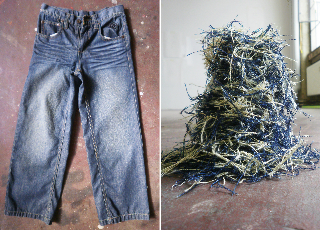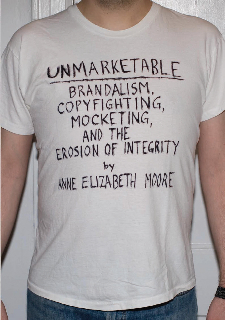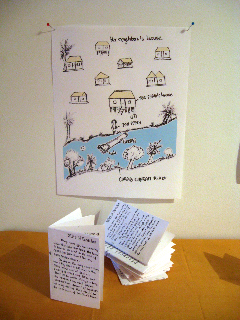This introduction is short. Anne Elizabeth Moore gave such thorough answers, it seemed more important to let those stand than offer an interpretation of her merit. Safe to say having published four books, Anne Elizabeth Moore is an accomplished author. Having shown internationally, she is a significant artist and permeating those facets of her work is a strategic, cultural investigation. She is presently on a Fulbright scholarship in Cambodia.
Caroline Picard: How would you characterize your work?
Anne Elizabeth Moore: Actually, I try not to characterize my work. This is the central issue in work that at its root hopes to investigate capitalism and the ethos of branding. Those boxes that make it easy to mark, identify, and sell something (either metaphorically or literally) also make it easy to either shut down criticism—if you identify with or have bought the item/idea/approach in question—or underscore it—if you are not the intended audience for that thing, pretending for a moment that we’re talking about “things. My work is like Justin Bieber if you like Justin Bieber: it defies categorization automatically because you adore it. But if you think Justin Bieber is a tool, then my work is not like that at all. In fact it is the opposite of that. Except for the fact that both Justin Bieber and I tend to be adored by teenage girls. That is exactly the same and there is no use denying it.
What I’m interested in is how easily systems of oppression become adopted and policed by the individuals they are aimed at oppressing. Branding is one of the primary ways this happens in the hyperconsumerist culture of the United States. But, like, you can’t just go get a job in that. You have to be a writer and an untrained lawyer and study sociology, and you have to speak a fair number of languages and appear friendly and approachable but also not be too scared when the guns come out. And also, because sometimes talking about this stuff is dangerous, you have to be willing to invent a new language, or perform, or work through ideas with a different, non-verbal part of your brain. Let’s be honest, if you study a lot of languages then you might get easily confused; sometimes you speak German or Italian to someone who only speaks Khmer, so visual communication—again, in its pure sense, as a two-way system, and not in the way they teach it at business school—is important.
So I have this pretty wide set of skills that I can apply to a situation that interests me. For sure I’m best known as a writer, but sometimes it takes a while for me to work through various issues visually, performatively, or educationally before I have worked out a language for them. If I have to settle on a one-word description, I prefer “writer” to “conceptual artist,” even though they are pretty much the same because “writer” makes more sense to the young people I work with in Southeast Asia. Sometimes even the title “artist” shuts doors we don’t notice.
CP: Could you talk a little bit about the importance of the zine, as a form?
AEM: I’ve been making zines since I was 11, so to me they’re important because they’re where I figured out my writing voice, established my audience, and learned how to publish, design, and illustrate. They’re important because they are very small spaces that you can control everything about and, often, feel safe exploring. That’s cool. If you’ve ever been told not to talk about certain things, not to speak in certain environments, not to speak a certain language—this can be very important. It’s a little bit of a different thing, or it can be, from freedom of expression. You don’t have to share this stuff. You can just work it out on your own. Knowing you have the potential to share it is sometimes enough.
But in the US, in the riot grrrl environment I came up in, it’s become such a given that people have access to a democratic infrastructure that they often don’t make use of it. In Cambodia, where I’ve done a fair amount of self-publishing work with young women, it’s not a given. Although photocopiers are common in the country and publishers aren’t, the notion of “writing your own idea” is almost unheard of. The country claims to be a democracy; in late 2007 Prime Minister Hun Sen explained that the notion “freedom of expression” in Cambodia is intended to mean the freedom to say anything positive you want about your government. Most of us think of that’s insane, because it’s removed from us, separate. But parallels to the US are obvious.
The thing is that in Cambodia, because I was working with young women, and because we were doing this thing that was small and intended for private use and in English and kinda secret (based on these), we got to create a space where no one knew, or cared, what a bunch of girls might be doing. And in a very gendernormative, traditional culture, this can be pretty amazing. Just like it was when I was a girl standing around the punk club, wondering why every other girl in the place was holding her boyfriend’s jacket.
CP: I think we met shortly before Punk Planet folded, and I remember afterwards you spoke about rapid change in the publishing industry. How have you’ve moved on from that realization, and how do you see your position as an individual, cultural producer?
AEM: I was a co-publisher of Punk Planet and the editor. I’ve spoken in hundreds of interviews about how, when Punk Planet folded, we were a canary in the coalmine, but we were the last canary in that particular coalmine. Meaning that US governmental policy and social acceptance of mainstream publishing had shifted enough in the 14-ish years of the mag’s existence that it was no longer possible to independently publish a print periodical on the scale we’d become accustomed to. This was happening at the same time that DIY became a branded entity, like that you could buy something from any of a range of corporate bodies, or you could buy it off Etsy or at a craft fair, where it was DIY. This was the subject of my popular 2007 book Unmarketable.
But this is not the DIY that I grew up with, where if you needed something, you DIYed. Right, DIY as a verb. So the problem wasn’t solely that it was now cost-prohibitive to publish your own magazine, the problem was that it didn’t occur to very many people any more. It was sort of lost as a genuine alternative. And this is mostly true. Sure there are still magazines, and some of them still claim independence, and some of those even are free of any sort of on-the-record corporate funding or foundation support. But most of them take ads, few of them look at what they do as an ethical or political choice, and every single one of them will hound you until you vote for them in the Pepsi Refresh Challenge or whatever equally inspid thing.
I’ve mostly continued to work in an independent mode since, because it helps me keep a perspective that I think has been valuable during this recession. To me that means not only that I don’t go work for McDonald’s or some proven unsustainable and ethically weird ESS, but that I refrain from affiliating with any larger body that may make decisions I’m uncomfortable with. But obviously working with other people or working in a larger context has benefits too, so, like, I teach at the School of the Art Institute of Chicago and show at the MCA, and am on a Fulbright in Cambodia right now. I think, too, I’ve not only gotten extremely depressed by the heteronormative and tiny independent publishing scene in the US, but I’ve gotten bored with how media operates. A stressed out country does not read, and they certainly do not react to what they read about with action. Don’t get me wrong: the destruction of the independent publishing scene goes against the founding principles of this country. The loss of sustained independent bodies of reporting has directly contributed to the tracking and cessation of further violations of civil and human rights in the US, not to mention allowed for unchecked limits to freedoms in academia and elsewhere. But I’ve also really enjoyed moving away from the idea that journalism is the only solution. Smart people can get the same information from different sources.
CP: You’ve spent a lot of time in Providence. How would you characterize the energy there?
AEM: Ugh, I actually haven’t been there in two years. Even people who aren’t from there keep reminding me that it’s been a long time since I was there. What’s great about Providence is that there’s a creative scene, like Portland, that embraces independent production, which is possible because it’s cheap (because there are basically no jobs), and ’cause there’s an art school that keeps energy flowing through the area. But unlike Portland, and more like Chicago and Phnom Penh, there’s a notoriously corrupt government that keeps everything at a certain level of crazy.
So places like this, and like Berlin and Leipzig and South Dakota where I was born, they’re really important in the way that I want to work, which is trans-locally. This is easy to comprehend when I’m working journalistically: like, I go to a place and I write about it, ask questions I think my audience would be interested in. But it’s a little more complex when I’m working in an art mode, where the trick is to invent a language that can be equally understood by subject and audience, or vice versa.
One of the really central questions in my work is, basically: How did that get to be normal? Or, Why is that OK? In South Dakota, for example, kids drink pickle juice. The hundreds of circumstances that are in place to get a kid to think it’s normal to drink pickle juice are really complicated, and rooted in these crazy socioeconomic and historical factors that can be traced back to before the founding of the US. So what happens on the reservation in South Dakota is kids drink pickle juice because there’s a longstanding rumor that it’s made from beer, and because they have nothing else to do, which leads to other questions: Why isn’t there anything else to do? Why would beer be so prized there? Why don’t their parents stop them? And of course their parents don’t stop them because they’re playing bingo or drinking themselves, or too busy with the other kids, or too stressed out with regular life. Beer is prized because of the way alcohol was introduced to the reservation and because alcoholism is therefore extremely common, and the attendant diabetes. And then there’s nothing else to do because that’s how you suppress dissent. Give them cable TV and beer and gambling, but make sure people have no incentive to and often can’t leave dry prairies, and have no income to afford proper farm implements, are sick most of the time and undereducated. So what else are you gonna do with your time? Drink pickle juice. Why not?
Every project I’ve worked on has started similarly: What happened to the Berlin Wall after communism ended? Why was only one woman nominated for an Eisner Award this year? How come Cambodian kids don’t know about the Khmer Rouge, when I do? How do the Olympics happen when research shows there isn’t any financial benefit to hosting them anymore? Why are bands that consider themselves independent taking money from big corporations?
CP: Tell me about Garment Work and your residence at the Leipziger Baumwollspinnerei…
AEM: Garment Work (2010) is a project I did in residence at the Leipziger Baumwollspinnerei, formerly one of the largest and longest-running textile mills in the world. It was a site for early radical socialist organizing and a haven of sorts under the GDR. The Baumwollspinnerei took a heavy hit when the Berlin Wall fell, and let most employees go, eventually ceasing production entirely and opening its doors to artists and galleries. Local demand for textiles, however, did not decrease in 1989, nor the products they are made from, and shortly after the fall of the Wall, an international policy was formulated called the Multi-Fibre Agreement. The MFA (which always confuses me—it means a totally different thing when talking about international trade than it does when you’re talking about art, which actually makes art about international trade kind of a pain) was created with the intention of allowing the world’s most impoverished countries the chance to enter the garment manufacturing game. Today, this agreement has ended, alongside the local benefits it ensured, so Cambodian women now make t-shirts and jeans for the US and Germany under harsh, unlivable conditions.

Anne Elizabeth Moore, "Garment Work," 2010
That’s the concept behind Garment Work . But what I did, really was spend 34 hours and 36 minutes over the course of three weeks taking apart a pair of jeans with my bare hands. It was an idea that came to me as I was researching the Spinnerei, which is now a famous art center (more specifically, a famous center in former East Germany for the very capitalist art market that supports dude painters), and because I had just spent the winter hanging out with garment workers in Cambodia, and also because I had just gotten out of a relationship with a German academic who writes about jeans. I was heartbroken, not just personally but politically, and all these interrelated structures were supporting and strengthening each other—I’d already spent the majority of my career trying to undo them them and it clearly wasn’t having any effect. So I tried this different way. I actually really did learn a lot about capitalism taking apart that pair of jeans.
The full installation of Garment Work incorporates video, a display of the constituent elements of a single pair of German-manufactured jeans, and a Tagebuch, kept in German, that references the Baumwollspinnerei’s Brigadebucher, regular diaries of sociopolitical life at the textile mill under the GDR. The Garment Work video distills my durational performance into a ten-hour video, basically of me taking apart a pair of jeans under the contemporary conditions of the former textile mill. The length of the video mimics the contemporary garment worker’s workday, inclusive of to ten-minute breaks, a short lunch, and mandatory overtime. Garment Work is a meditation on capitalism, integrity, loss, and perseverance. It actually hasn’t been displayed in the US yet, but there’s a preview video of it on YouTube. I’ll exhibit it at Meta-House in Phnom Penh in January, which opened on the 5th of January!
Go here to read more about copyright and AEM’s Fulbright.








Pingback: Democracy Guest List
Pingback: Pre-order Cambodian Grrrl « Democracy Guest List
Pingback: Garment Work « Anne Elizabeth Moore